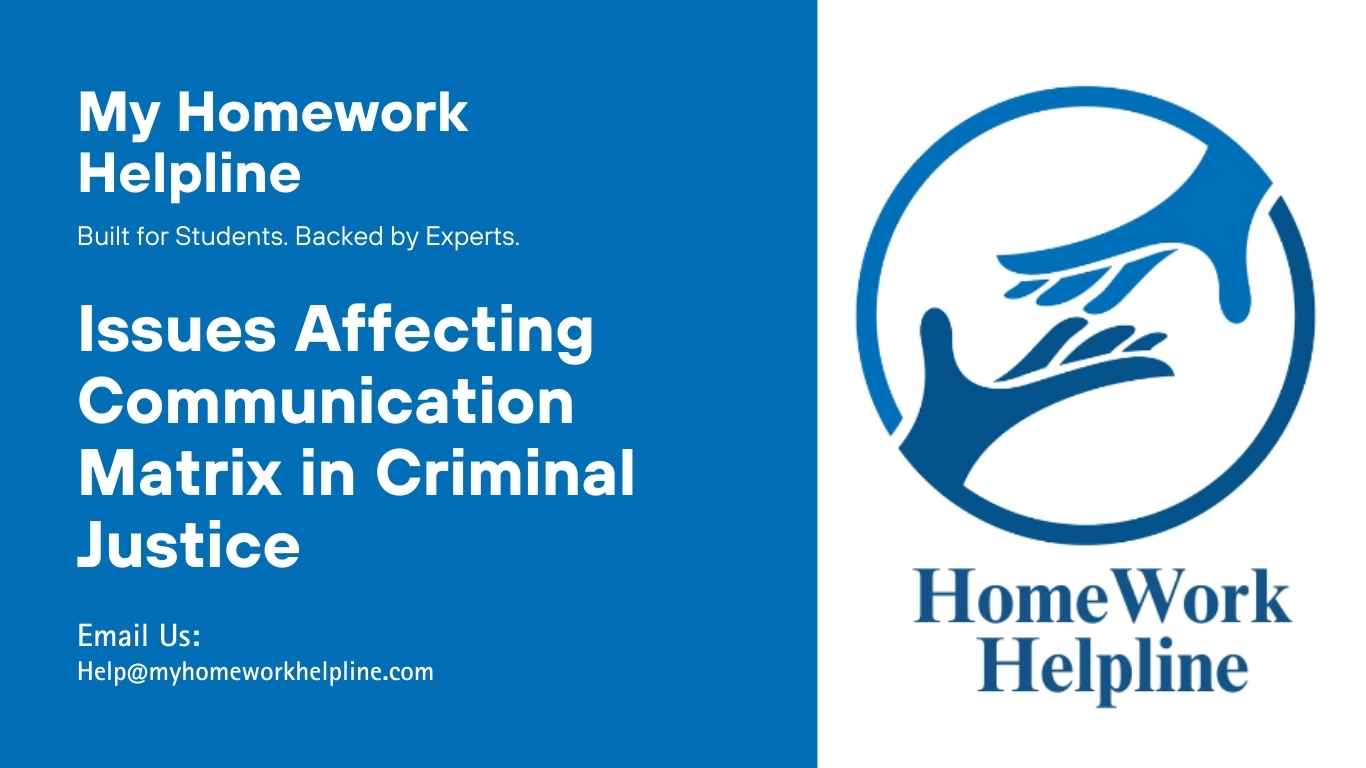Issues Affecting Communication Matrix: CJA/444 R 8 Analysis
| Communication Concept | Scenario Illustrating Ineffective Communication | Solution for Effective Communication
|
|
| 1 | Horizontal Communication | The individual in charge of the department concluded that he would decide by himself, without contacting the other manager, which would result in the department receiving less remuneration. | The best way to address this issue is for both managers to collaborate on decision-making and effectively lead their respective divisions. If they have a conversation about the possibilities and collectively arrive at a decision, they won’t have to worry about losing their pay. |
| 2 | Cluster Chain Communication | The unreliable management relayed inaccurate information, ultimately leading to a communication breakdown. | For communication to be successful, it must first originate from a trustworthy individual and then make its way via a series of trustworthy employees. |
| 3 | Probability Chain Communication | It is not an efficient method of communication since the messages can quickly become jumbled. | This information can be passed on from one person to the next in a chain reaction that begins with one person and ends with one person. |
| 4 | Gossip Chain Communication | This information is not very relevant. Someone shares information with a group of individuals, who in turn share the information with other groups of people, further confusing the communication. | One strategy for ensuring the success of this communication is to ensure that dependable individuals relay it to other dependable individuals. |
| 5 | Upward Communication | Communication was transmitted from the worker at the bottom of the chain to the highest worker. | Any information, such as a loss, falls under this communication category, and it can be discussed unrestrictedly. |
| 6 | Written Communication | A dispute amongst employees was sparked by a message that was poorly written and phrased. | This issue may be resolved by carefully crafting the language of your communication. You may have fewer misunderstandings and disagreements if you learn to utilize more significant words rather than smaller ones. |
| 7 | Oral Communication | In oral communication, one-sided communication might be confusing for both parties. | In order to rectify this situation, you will need to ensure that spoken communication consists of more than just one-way communication. Everyone will have their say, which should clear up any misunderstandings or conflicts that may have arisen. |
| 8 | Non-Verbal Communication | The management was communicating with his employees in a manner that was not verbal, and it gave the impression that they were in trouble due to the manager’s attitude. | When employing non-verbal communication, it is essential to ensure that you are in an excellent mood to smile and nod to the person you are speaking to. |
| 9 | Physical Non-Verbal Communication | The fact that I was resting my head in my palms gave the impression to my colleagues that I was unhappy with them. | To solve this grin, make pleasant conversation with your hands and avoid leaning your head on your hands when other members of the team are speaking. Also, you should train yourself not to let your voice reflect your irritation. |
| 10 | Paralanguage Communication | My tone of speech caused the team to feel as though they were being mistreated and screamed at, which contributed to their high level of frustration. | The capacity to read between the lines is referred to as paralanguage. To find a solution to this problem, each team member needs to become familiar with the others so that this issue does not get confused with dissatisfaction or rage. |
| 11 | Aesthetic Communication | I attempted to convey my message through art; unfortunately, it was misinterpreted since the artwork was not created correctly. | To use this mode of communication effectively, one must have a high level of creative ability so that they are not readily misconstrued. |
| 12 | Appearance | Because I did not put much effort into my look, no one took my advice seriously and thought I was serious about our job together. | The way you dress may reveal a lot about your personality. If you want to be taken seriously and listened to when you are working, either independently or in a group, you must present yourself professionally. |
| 13 | Social Media | Using social media to keep everyone updated on my day-to-day existence, including the details of my gripes and complaints (Chen & Wei, 2020). | Social media platforms allow users to stay in touch with their friends, which is a wonderful thing; however, not everything should be shared on these platforms. Allow other people to be the mistress of your life. Do not give the impression to other people that you are always sad. |
| 14 | Message Decoding | As a result of the message not being deciphered correctly, it caused a great deal of distress for a significant number of individuals and also started a dispute. | Avoid using this mode of communication unless you or someone else in the group is an expert at decoding messages. This is the most straightforward and most effective technique for employing message decoding. |
| 15 | Filtering | I censored my message and kept my opinions to myself so that I wouldn’t harm anybody else’s feelings, but in the end, the filtering of the message damaged my feelings. | Learn not to withhold information when filtering based on the possible reaction of another person; instead, figure out how to handle this situation. |
| 16 | Video Conferencing | Due to the weak internet connection, the material presented at the meeting could not be heard well when I was participating in a video conference. Because not all words were adequately heard, the information had to be cobbled together. | To maximize the usefulness of this method, you need to ensure that you have a reliable internet connection and turn off any other electronic devices you want to use during the video conference meeting. |
| 17 | Telephone | When I was participating in a three-way phone conversation with my team, I could not hear everything that was said since there was a lot of noise on one of the other ends of the call, which diverted my attention. | Request in an appropriate manner that the other team members move to a more quiet location so that no one is distracted and we can all comprehend what is being said appropriately. |
| 18 | PowerPoint | The PowerPoint presentation was difficult to concentrate on and just distracting because it was crammed to the gills with material and the visuals were overly busy. | To resolve this issue, instruct the individual in the correct way to set up a PowerPoint presentation. When this is done, the relevant information that has to be conveyed should be condensed into bullet points, along with speaker notes and illustrations that assist in describing the issues. |
| 19 | Due to the fact that the recipient’s email address was incorrect, the email was sent to the wrong individual. As a result, I was reprimanded for my tardiness in turning in the project. | When communicating with someone by email, confirming more than once that the recipient has received the message is recommended because emails may quickly go misplaced on the web. | |
| 20 | Downward communication | The chief made the announcement of the imminent changes in procedure verbally during a meeting that was attended by some of the employees but not all of them. The presentation was unclear and raised more concerns than it answered, and workers who were not there did not obtain the information that was intended for them. | The adage that “written communication is typically the most trustworthy form for complicated communication” is, in most cases, the best practice (Robbins & Judge, 2017, p. 360). Before the new policies were put into force, a comprehensive annex was included to the handbook that outlines operational procedures. The chief gave training to supervisors so that they would be better prepared to answer inquiries and ensure that the policy was followed. |
References
Chen, X., & Wei, S. (2020). The impact of social media uses for communication and social exchange relationships on employee performance. Journal of knowledge management. https://www.emerald.com/insight/content/doi/10.1108/JKM-04-2019-0167/full/html?casa_token=2JW0Po-3y0oAAAAA:mkt5m6C54V8X3DQct2_U5UsybkoK4f4jpXvdkx8s8kiw-0bTKf7qmBMUrGtlA53iNvyGdzpH3ew8vOuIaTNgt1Q7IQETHMqn1xyLYCY32gFTUdwXcjPS
Robbins, S. P., & Judge, T. A. (2017). Organizational behavior. (17th ed.) Upper Saddle River, NJ: Prentice Hall.
Struggling to analyze the Issues Affecting Communication Matrix for your CJA/444 R 8 coursework? Our team specializes in guiding students through criminal justice assignments with step-by-step homework assistance. From understanding communication barriers to crafting structured responses, we provide the support you need. Get expert help today by visiting our criminal justice homework helpline and make your work both accurate and impactful.

